How to Plan a Trip in 10 Full Steps | International Travel

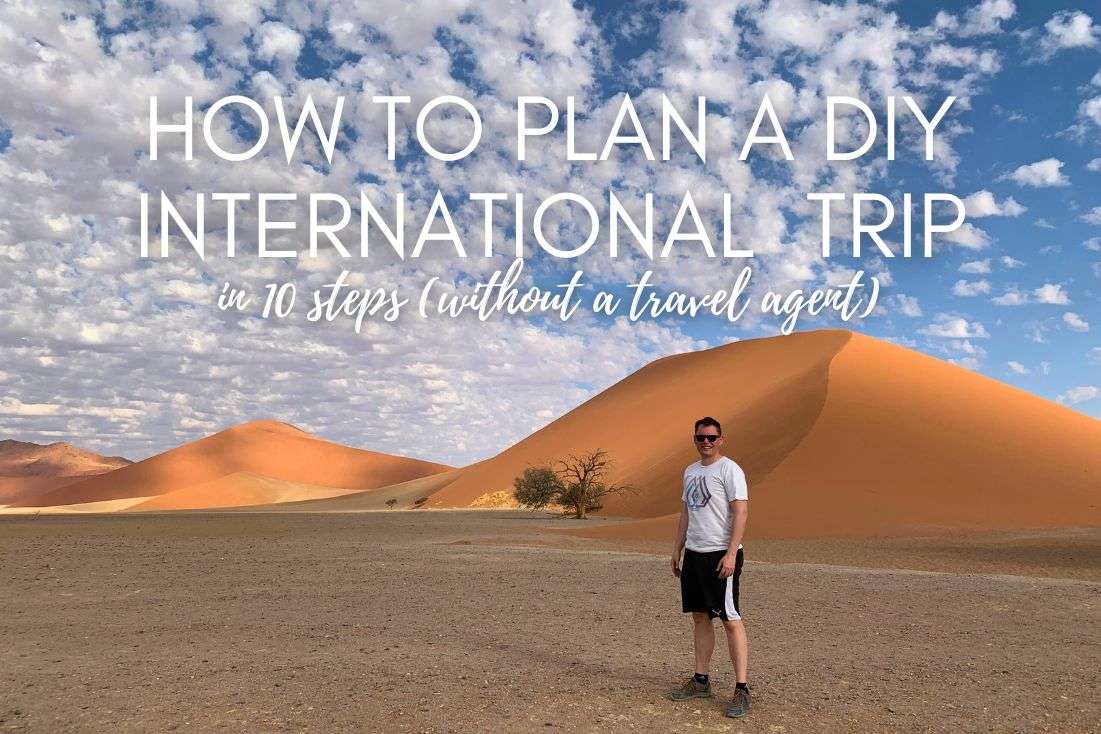
Planning your first trip is equal parts exciting and daunting. If you’re figuring out how to plan an international trip to a far-off continent, you're bound to be overwhelmed. Flights, visas, accommodation, transportation… your to-do list is about to look like a novel. Hell, even if you’re a European just trying to figure out how to plan a trip to Europe, I wouldn’t blame you for feeling lost.
But don’t worry—I’ve got you. I’ve been to more countries than I can count (okay, I can count them, but it sounds cooler this way). In my rich experience, I’ve learned that a well-planned trip is the difference between an epic adventure and a logistical nightmare.
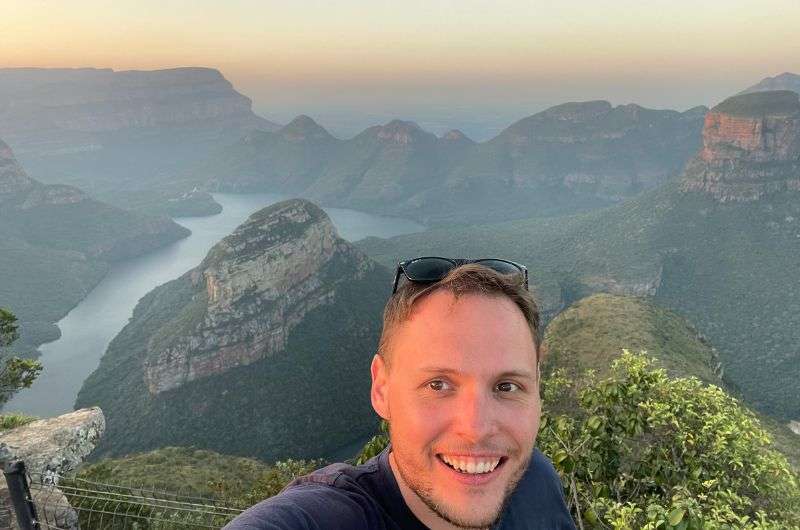
Take in the view at Blyde River Canyon along South Africa’s Panorama Route. A quiet moment before the next stretch of the journey
Tip number one: DON'T use a travel agency!
Sure, you could pay a travel agency to handle everything, but where’s the fun in that?! They’ll only overcharge you for cookie-cutter itineraries when you could be crafting your own perfect trip—one that actually fits your budget, interests, and tolerance for chaos.
This guide of mine is as real as it gets: 10 steps, no fluff, and unique, practical tips you’ll actually put into action to plan your first international trip. And once you’ve followed it once, you’ll be a travel pro, ready to take on the world again and again. Let’s get to it!

Floating in Yaxmuul cenote, tucked away in Tulum’s jungle
The trip-planning process: some key tips
- Ask yourself, “What do I want from this trip?”
- Work out your total travel budget before doing anything else
- Find out whether a country is safe for you to visit and whether you’ll need a visa
- Be as flexible as possible with your travel dates
- Find out whether you can get travel insurance from your credit card company
- Use Wikipedia to get a clear idea of available flight routes
- Always buy flight tickets directly from the airline
- Carefully check which amenities your accommodation comes with
- DON’T plan to go to the “must-sees” if they don’t interest you
- Learn some useful phrases in the local language
- Make lots of packing lists, but don’t overpack
- Calibrate and compromise with your travel companion(s) throughout the process
Step 1: Decide on what you want from your international trip

Somewhere in Namibia, with nothing but open roads and mountains ahead (and lots and lots of sand!)
When it comes to any goal in life, having concrete wishes and expectations from the get-go is the best way to avoid disappointment. (Thanks for coming to my TED Talk.)
It’s important, first of all, to delve into exactly why you want to take an international trip to have the best chance of a great experience in the end. This is one of the more fun steps, one that requires maximum imagination and minimum research.
Ask yourself, “What kind of traveler am I?”
...and begin to create the blueprint for your perfect trip by posing multiple-choice sub-questions, such as:
- “Do I prefer to travel by plane or on land?”
- “Am I looking for a culture shock or an environment more familiar?”
- “Am I a city or countryside person?”
- “Do I want adventure or relaxation?”
- “Do I like hot or cool weather?”
- “Do I want to be active or take it easy?”
- “Do I like outdoor or indoor activities?”
- “Can I sleep anywhere, or will only a nice hotel do?”
- “Do I want to be there for a weekend, a week, or longer?”
- “Do I want to travel solo or accompanied?”
Pro tip: If you want to travel with several other people, it’s crucial to make sure you calibrate your needs and preferences at this early stage. Get together—in person, not in a WhatsApp group—to talk frankly about all the things you can and can’t compromise on. Make sure you take notes!
And because I know you’re simply dying to know, if I were planning my next trip right now, my answers to these questions would be:
- “By plane.”
- “An environment more familiar.”
- “Countryside.”
- “Adventure.”
- “Hot weather.”
- “Active.”
- “Outdoor.”
- “A nice hotel.”
- “A week.”
- “Accompanied.”
These are only ten criteria, but the concept of my trip is already pretty streamlined. This is what’s going to help me in the following stages of planning my international trip.
Step 2: Decide on your travel budget
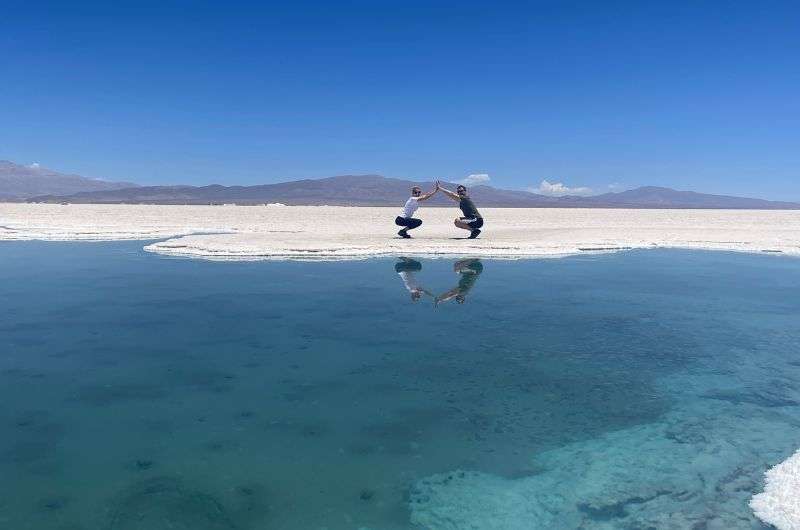
Salt flats and reflections in Jujuy, Argentina
By “travel budget”, I mean the maximum amount of money you’d be willing to set aside for every part of your trip. This includes:
- Travel insurance
- Visas
- Vaccinations
- Transport
- Accommodation
- Food and drink
- Activities
- Cash for shopping
The reason I suggest you note down the maximum amount of money is that it gives you a hard, fixed limit to work with when you come to the following steps. In other words, it’ll help you not to waste time browsing and researching options that will take you beyond your budget.
This maximum will obviously vary wildly from person to person, depending on their financial situation. For my imaginary week-long vacation, let’s say I can afford to reserve EUR 3,500.
Useful resource: TravelSpend is an app that lets you log your travel expenses in multiple currencies, set budgets according to spending categories, and generate expense reports. It’s something to use once you’re on the go rather than in the planning stage, but I just had to plug it for being super user-friendly!
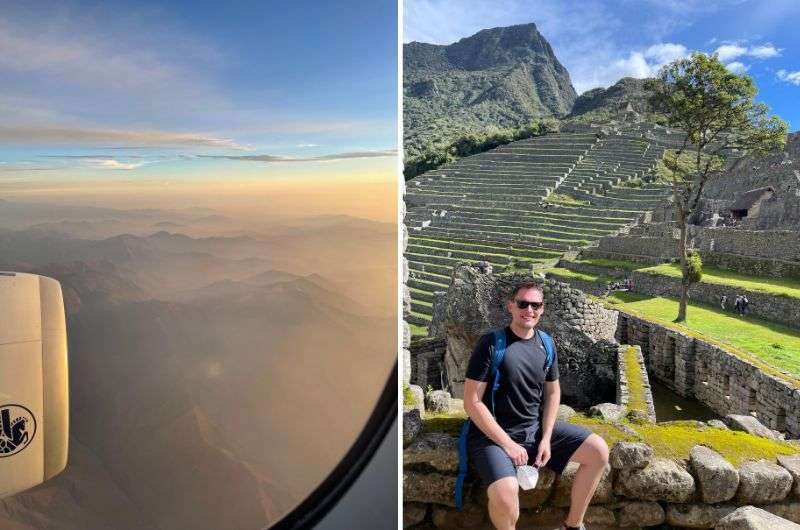
From the skies to the ancient ruins—I finally made it to Machu Picchu
How to calculate a travel budget if you’re traveling in a group
If you’re traveling with other people, they should consider their own individual maximums. If everyone decides to make everyone’s inclusion a priority, then you should all lower your maximums to match the lowest budget in the group. This ensures that nobody gets priced (and left) out of destinations, accommodation, or activities that others can afford.
For example, if my girlfriend—my only (very much wanted) travel companion—can only afford to spend EUR 3,000, my own budget is also reduced to EUR 3,000.
Step 3: Decide on your destination
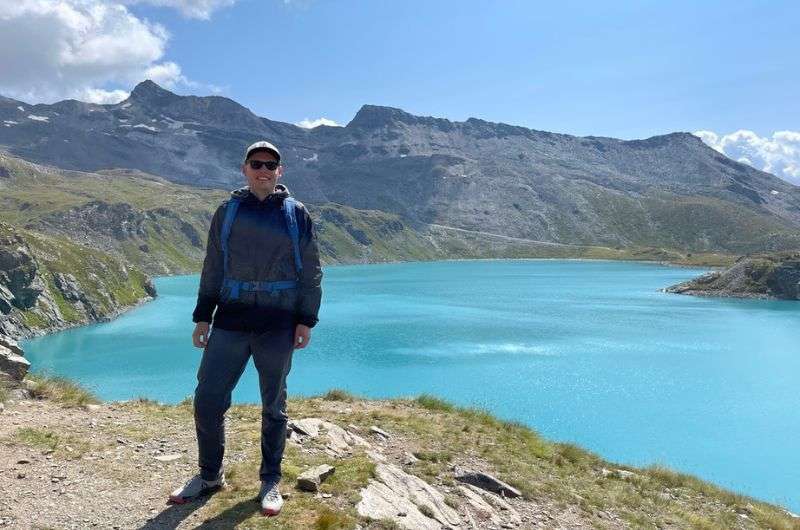
High-altitude blues at Lago del Goillet, Italy. A perfect spot for an active escape
Now, here’s where your vacation really starts to feel real! Take your trip criteria from Step 1 and start by looking for regions where they’re likely to be fulfilled. For starters, you can look at the Destinations section on my travel blog and let the inspiration juices flow.
In my case, I know I want an active, outdoorsy vacation, but I wouldn’t want to leave Europe (where I live) on account of wanting a more familiar location and not wanting to spend more than EUR 3,000 for one week.
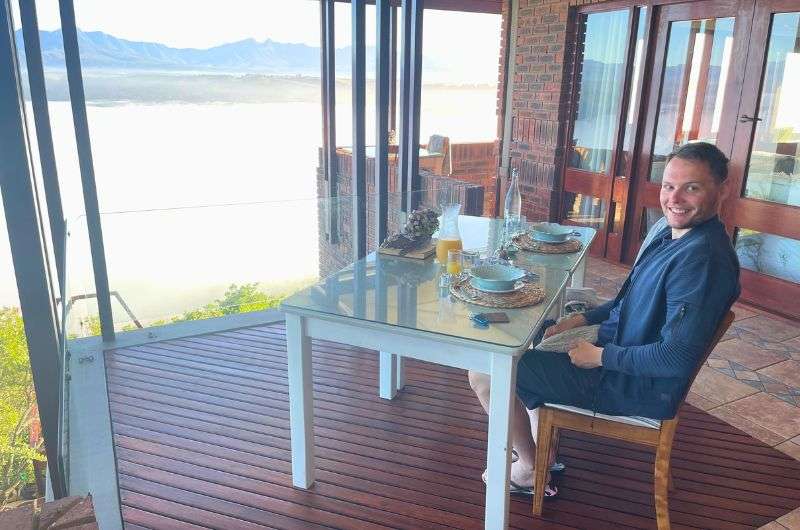
Breakfast with a view at what was my favorite hotel along South Africa’s Garden Route: Kambaku @ Sea
For example, I’d Google “Where in Europe is good for hiking?”
...and I’d get suggestions like “Scotland”, “Iceland”, “Norway”, “Austria”, “Italy”, and “the Pyrenees”. Time to glance back at my criteria again!
Let’s be real—we’re not getting hot weather from any of the first three options, plus they’d all be beyond our budget. I want to go somewhere further from where I live (the Czech Republic) than Austria. I mean, I don’t want a total culture shock, but I’m feeling more adventurous than simply hopping next door.
And then, bearing in mind our calibrate-and-compromise discussion (also from Step 1), my girlfriend would highly prefer to go somewhere we’ve never been together before. That would rule out Italy, so the Pyrenees it would be.
You might also be interested in:

Research further to make double sure this country is right for you
Don't forget to consider the finer details of what’s important to you personally. You don’t want to be getting off a plane in Saudi Arabia if you’re transgender, only to learn at that stage that they’re not so cool with you.
Okay, that’s an extreme example, but once you think you’ve settled on a destination, go over it one last time, bearing in mind factors such as:
- Severity of language barrier
- Likelihood of natural disasters
- Traveler safety and security
- Accessibility for the less able-bodied
- Potential societal reactions toward solo women, LGBTQ+ people, people of color, or people of a certain nationality
- Local customs
- Vaccinations and their cost
- Visa and other entry requirements, their cost, and their processing time
Important note: Check your passport expiration date at this stage to ensure it has enough validity left. If you’re not an EU passport holder, you also need to bear in mind that your passport can’t be more than 10 years old to enter the EU, regardless of its expiration date.
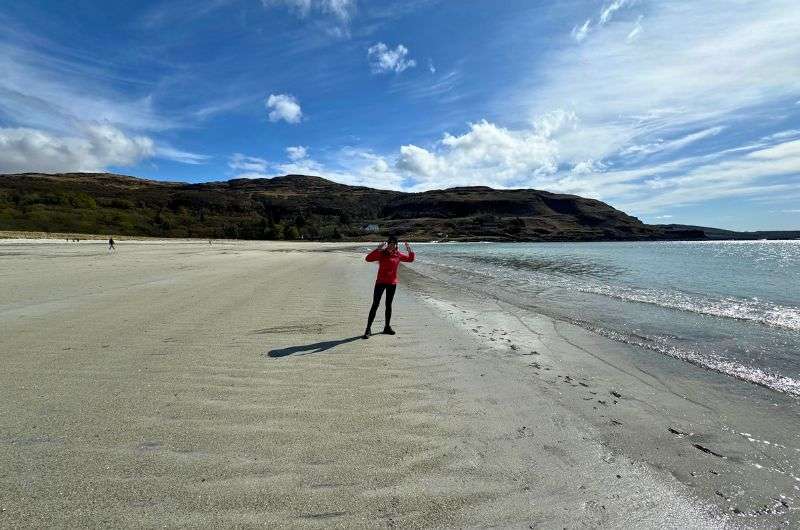
Quiet moments on Calgary Beach, Isle of Mull, Scotland. A place to slow down and take it in

I’m lucky in that I don’t need to make many of the considerations above anyway, pretty much wherever I go (straight-white-male privilege flex!). But for the sake of my example trip plan, it’s fair to say that the Pyrenees are a safe and practical place for me and my girlfriend to visit, in all regards.
Step 4: Set your travel dates
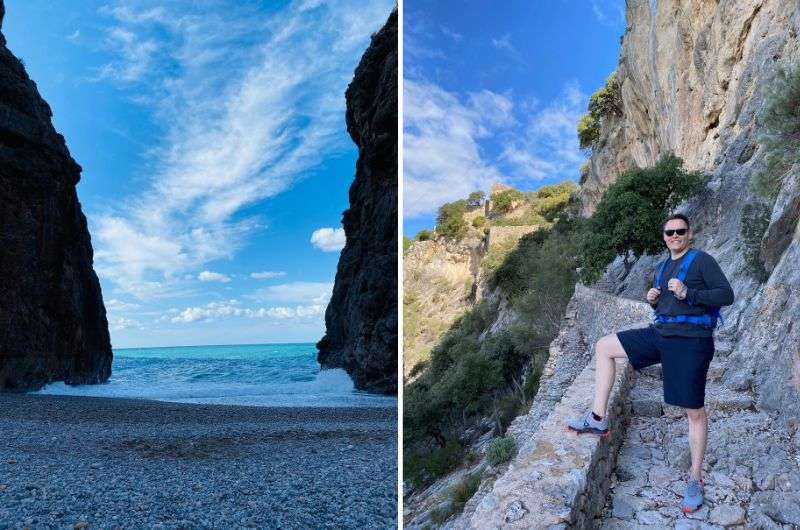
Exploring both the coast and the trails of Mallorca, Spain. A mix of sea and mountains in one trip
Unless you’re a kept man or woman with zero responsibilities year-round, there’s a fair chance that you already have an idea of when you’ll be free to set off on your vacation. By all means, stick with that time slot, but here are some more factors to check you’ve thought about before proceeding:
- Whether your travel companion(s) will also be available (the most important, obviously)
- What the weather will be like
- When the peak travel seasons are
- Whether there’ll be any local festivals running, or even protests or other events (either to participate in or to avoid)
As it happens, my girlfriend and I are relatively flexible with travel dates. I took the liberty of Googling “best time to go to the Pyrenees” and eventually decided on the second week in September.
Step 5: Get travel insurance

Airport waits and window seat views—part of the journey, wherever it leads
Look, I get it—no one gets excited about buying travel insurance. It’s like packing an umbrella—annoying, but essential unless you enjoy tempting fate. Lost luggage, medical emergencies, or a last-minute flight cancellation can turn your dream vacation into a financial nightmare. So for God’s sake, do yourself a favor and insure your trip!
Be budget-conscious: Remember that the further away from home you go and the more vigorous your activities are, the more expensive an adequate insurance plan is likely to be.

Exploring the Alcazaba fortress in Málaga—history, architecture, and a view over the city
What to look for in a travel insurance package
Not all travel insurance is created equal. Some policies cover everything but spontaneous skydiving; others barely cover a paper cut. Of course, exactly what you’ll need depends on what kind of trip you’re taking. But in general, prioritize things like:
- Medical coverage
- Trip cancellation
- Lost or stolen belongings
- Adventure sports coverage
- 24/7 assistance
Pro tip: Find out whether your credit card provider offers travel insurance. Some providers include a plan when you pay for flight tickets, for instance. This would certainly save you a lot of hassle!
For a solid provider, I recommend World Nomads (worldnomads.com). They cover adventure activities, have flexible plans, and don’t disappear when you actually need them. Plus, they were founded by fellow travelers, not soulless insurance robots.
Step 6: Buy plane tickets

Long-haul flights are all about the little comforts—good seats, decent entertainment, and a solid plan for passing the time
It’s time to commit. I always get a minor adrenaline rush when I book flight tickets because it's when I know there’s no going back—this trip is happening!
Disclaimer: I don’t usually travel on international or intercity buses and trains, and the way they work is very specific according to the locality anyway. Therefore, you get my best travel-planning tips when it comes to arranging air transport and hiring cars:
- Choose your departure and arrival airports wisely by consulting a map. Some airports are shockingly far from the destination in their name (which is there entirely for marketing purposes). Fun fact: Paris-Vatry Airport is 147 km (91.3 mi) from Paris. Yep, you’re literally being taken for a ride!
- Pay close attention to flight departure and arrival times—they can make a difference to the feasibility of a plan. Sure, a 7 am flight might sound doable, but will you be able to get to the airport at least two hours prior to that? And will you definitely be able to pick up a car right away if your flight arrives at midnight...?
- Similarly, double-check the luggage allowance that comes with your ticket. You can always pay for more baggage, but it’s nice to know that you’ll need to pay for more baggage.
- Make sure there’s a hire-car provider at your arrival airport. This one seems like a no-brainer, but bear in mind that not all airports have one, and even less often are they open 24 hours.
- Read up on the driving laws and regulations in your destination country. Don’t assume that they’ll be the same as at home, and you might even need to bring extra documentation in addition to your license.
Useful resource: This is my very own top time-saving hack. Before booking any flights, I always look at an airport’s Wikipedia article (yes, I am a nerd). There should be an up-to-date table showing which destinations are served by that airport and the airlines that serve them. Then, you can go directly to the relevant airline’s website to check availability in more detail.
Another useful resource: If you’re considering buying plane tickets from a carrier you’ve never flown with before, head to skytraxratings.com for comprehensive, certified ratings of pretty much every airline in the world. The truth comes out here!
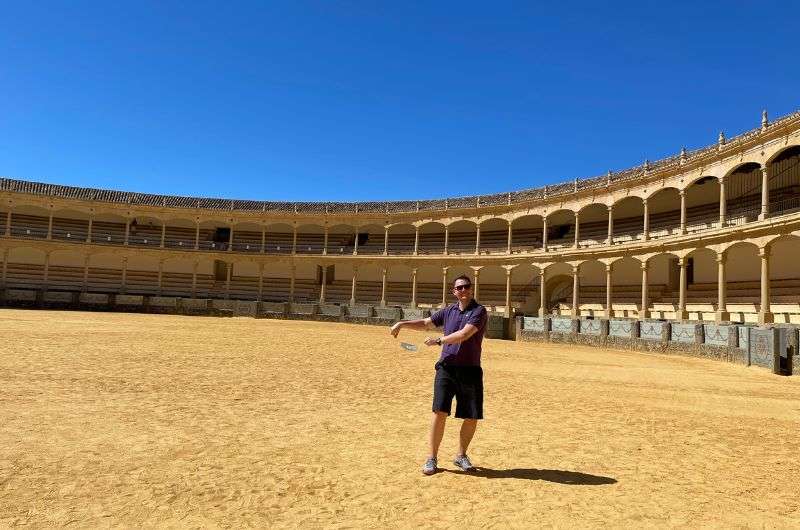
I'm chasing the best tickets in the arena...
Remember to keep your budget in mind...
- Skip the middleman! No matter what they say in their promotional materials, it is more expensive to book flight tickets through a travel or ticketing agency. Plus, you might find that the airline won’t want to communicate with you afterward if you didn’t book directly with them. I’ve been there, and I can’t tell you how frustrating it is to be sent back and forth between the airline and the agency like a volleyball when all you want is some help.
- Start browsing flights as far in advance as possible. There’s some research to suggest that the sweet spot for buying the cheapest tickets is 2–4 months before the departure date (pro tip). Generally, the cheapest days to fly are Tuesday, Wednesday, and Thursday.
- Because airlines are becoming more cheapskate than ever, many of them don’t include checked luggage with their tickets anymore. Therefore, if you can fit a vacation’s worth of stuff into your cabin baggage allowance, it’s a good idea to do it.

Chill out on our way to Chille
How I find and book my flights: step-by-step
Okay, this Pyrenees trip of mine is still imaginary. But if it weren’t, this is how I’d get the most suitable flights for it. (And I did find them this way; I just didn’t actually book the tickets.)
- Decided that we wanted to fly from Prague (in our home country, the Czech Republic)
- Look for airports in or near the Pyrenees in the “Airlines and destinations” table on the Wikipedia page for Prague Airport*
- Find that a direct Prague–Bilbao route is served by Vueling
- Look for flights for the second week of September on Vueling’s website
- Find round-trip flights that line up with our preferred dates, budget, and ideal times of day to travel**
- Confirm (with Professor Google) that there’s at least one rental car provider at Bilbao Airport
- Book our flight tickets from Prague to Bilbao
*If your geography’s not up to scratch (can’t relate), use Google Maps to find airports near your final destination.
**This isn’t guaranteed to happen on your first flight search. If you can’t find anything suitable for you, go back to point 2 (or even point 1 if necessary).
You see—you can totally be your own travel agent! And for more hacks for getting the best plan tickets, don’t hesitate to click here...

Step 7: Decide on and book your accommodation

Comfortable bed, beautiful view, beautiful scenery... @ Ndhula Luxury Tented Lodge, South Africa
You’ll already have a rough idea of the sort of place you’d like to stay from Step 1, be it in a fancy hotel, a self-catering apartment, or a tent. You do you, but personally, I only ever stay at hotels.
Useful resource: I always use Booking.com to reserve hotel rooms. From searching for a hotel to managing a booking, the app is super easy to use, and the reviews that other travelers leave are detailed and impartial. Okay, I know I’m shouting about how great it is to cut out the middleman, but this is an exception (plus, you can get discounts as part of a loyalty program!).
Things to consider when searching for travel accommodation
- How far it is from the town, city, or other main attraction
- Your budget
- The amenities offered (Wi-Fi?, A pool? A filling breakfast? Parking? Someone to come and lovingly massage your tired feet after each long day?)
- Reviews (but don’t get too hung up on every little detail)
- The wants or needs of your travel companion(s) (the most important; think back to your calibrate-and-compromise discussion)

An unbearably hot outside... The swimming pool in the hotel—yep, I'll take it
As it was when you decided on your destination in Step 3, thorough research is key at this point. If you think you know all you need to know about the accommodation you’ve found, stop and consider these finer points...
- Check-in and check-out times
- Availability of parking spaces
- Safety level in the neighborhood
- Availability of public transport
- Availability of lockers or safes
- Accessibility for the less able-bodied
- Hidden fees
After carefully considering everything above, I picked out the Gran Hotel de Jaca for us to stay at in the foothills of the Spanish Pyrenees. (It looks so pristine, bright, and modern inside that I’m starting to think of planning this trip for real...)
Want more tips on booking the best hotels? I hear you:

Step 8: Decide on your activities
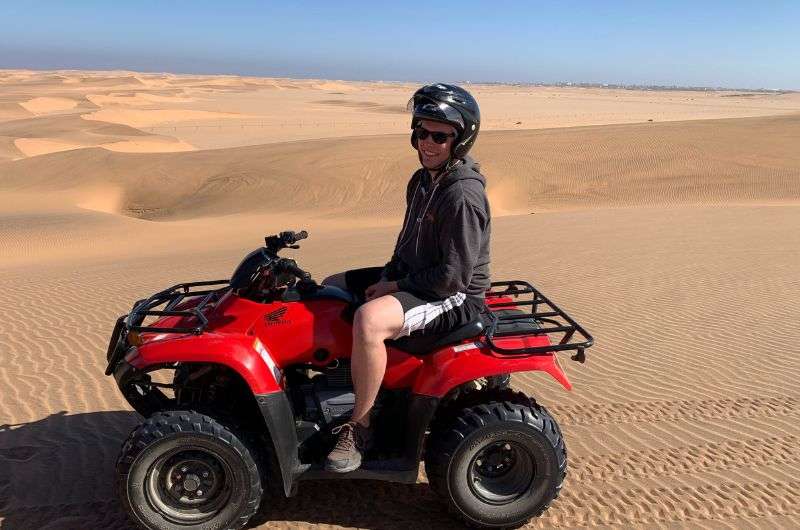
Fast and furious in Swakopmund Namib Dessert, Namibia... but with respect for nature
This is another exciting step—the very reason you’re making this trip! Again, after Steps 1 and 3, you might well have an idea of the main thing you want at your destination (in my case, it’s hiking and general outdoor adventure). But now’s your chance to fine-tune this idea as well as brainstorm on other attractions that might be worth visiting.
Useful resource: Viator.com is a great starting point for finding fun things to do all over the world. It kind of works similarly to Booking.com—with reservation capabilities, reviews, and a rewards system—only for activities.
Things to do on vacation: My top tips
- Book activities in advance wherever possible. It’s one less thing you have to remember when vacation time comes, You might get a discount, or even more importantly, it might be mandatory.
- Don’t feel like you need to see the most popular attraction if you genuinely have zero interest in it. In other words, don’t waste your time and money on the Louvre if you don’t like art galleries.
- Prioritize what to do according to your wishes and your budget. If your primary reason for going to Las Vegas is that you love gambling, face the probable reality that you won’t do much else.
- Some places are worth seeing with a (human or audio) guide. I’ve been on plenty of guided tours—in the historic buildings of Edinburgh, of the Pinacoteca Nazionale in Bologna, even in the Andes—and I can truthfully say that this is how you get the most in-depth understanding of a place.
- If you’re sightseeing in a city, find out whether the local tourist board offers any passes that’ll admit you to several places of interest at a reduced price. For example, when we visited Padua last year, we got a ticket for just EUR 12 that got us into three spectacular sites.
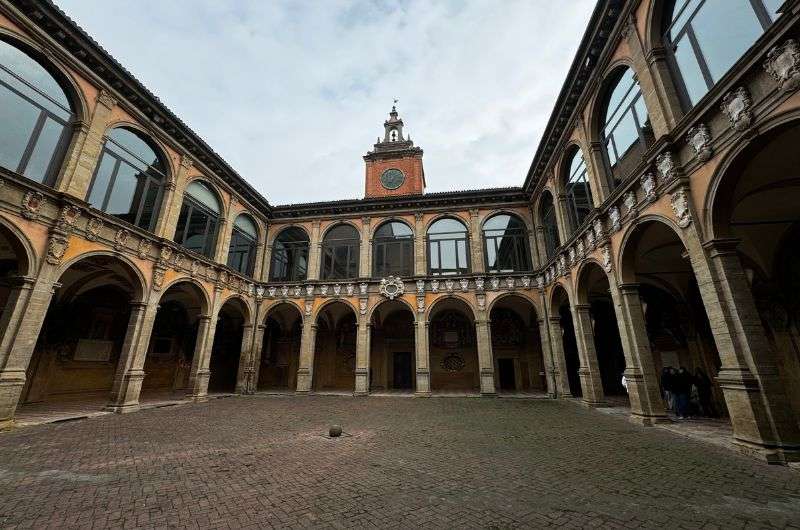
Bologna is not just a delicious pasta dish...
If you’re traveling with other people, perhaps now more than ever, you need to coordinate with them. Teamwork makes the dream work (that’s what people say, right?)—get back together with your pals to research and decide on what you’d all like to do on your joint vacation.
And if you’re especially organized, you could even start planning your days in detail...
How to create a vacation itinerary: step-by-step
I am a master at drawing up travel itineraries! I should really start a career in it, but until I do, I’ll humbly let you in on my systematic, nine-point method.
But first, one important thing I should point out is: if something doesn’t go according to plan on your vacation itinerary, remember that it doesn’t matter in the long run. You’ll still have a good time, and you can always think of patch solutions on the spot.
- Make a list of all the things you've decided to see and do on your vacation
- Note down opening times or any other best times of day for each activity (you don’t want to be hiking up a mountain in the dark, for instance)
- Note down roughly how long you’ll spend doing each activity
- Pinpoint every location on a map (Google Maps is useful for this)
- Piece together day-long (6–8-hour) plans by grouping together attractions that are close in distance and by using the information collected at points 2 and 3
- Once you have enough day-long plans for the number of full days you’ll spend on vacation, research travel times (Google Maps is also useful for this, whether you’re driving or using public transport)
- Slot these travel times into each day-long plan
- Assign each day-long plan to a full vacation day
- If any days seem unrealistically long at this stage, tweak the itinerary until you’re happy (you could move some things to your arrival day and/or departure day, depending on how much time you have to spare)

Step 9: Learn a few phrases in the local language

Can you order food in the local language? @ Modena, Italy
So, now you’ve got a budget, a destination, travel insurance (seriously—don’t skip out on it!), travel tickets, accommodation, and plans for what to see and do. That’s the hardest stuff over! Next, it’s time to kick-start the fun by attempting to immerse yourself... while still at home.
I’ve learned phrases in lots of languages courtesy of my travels around the world, and there is something incredibly satisfying about it. I’d say Spanish and Italian are the languages I’ve become most confident in, largely because natives of Italy and South America aren’t the most proficient English speakers. (And, well, as far as languages go, they’re pretty easy.)

Standing in the shadow of history at the Segovia Aqueduct—centuries-old engineering still making an impression
Why speak the local language on vacation?
I mean, if “so not to be an ignorant bastard” doesn’t answer this question, here, read these reasons:
- You’ll feel less like a clueless tourist. To put it bluntly, pointing at a menu and saying nothing will make you feel dumb. But knowing even just a few words can really elevate your confidence in a new place.
- In a similar way, you’ll get better service. Locals appreciate the effort, even if you butcher the pronunciation.
- You’ll avoid getting ripped off. Vendors are less likely to overcharge someone who understands the difference between “five” and “fifty”.
- You’ll make instant friends. Saying “cheers” to other drinkers in the local language is basically a universal friendship hack.
- You’ll handle emergencies better. Shouting “HELP!” in English might not get you far in a rural village. Of course, no one hopes to be in this situation, but knowing how to say “doctor” or “police” could be a lifesaver.
- You’ll get more out of the local culture. You might learn that what you thought was “just a coffee” comes with a story of fascinating tradition... or a bonus snack.
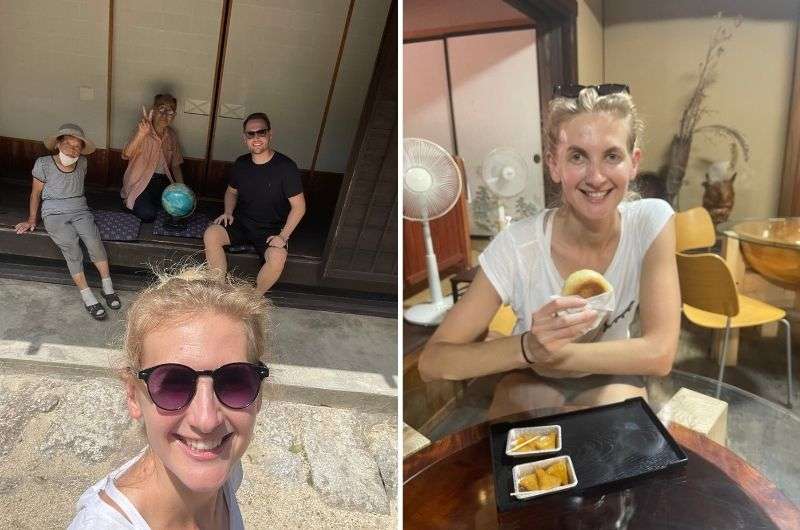
When words fail, hand gestures will do—communicating with locals in Nagano, Japan
Useful resource: Not Duolingo. A controversial opinion, maybe, but I don’t think it offers much progress for occasional travelers or for serious language learners. Instead, I find the Memrise app to be very vocab-focused, using flashcards and “Learning With Locals” video clips to help get the important words drilled into your head.
Other useful resources: Google Translate and DeepL are the best apps for translating things once you’re on the go. DeepL provides slightly better translations for most languages, but it comes with a tighter character limit. Both apps also come with a lens feature that can translate physically written text using your phone’s camera.
Step 10: Pack for your international trip
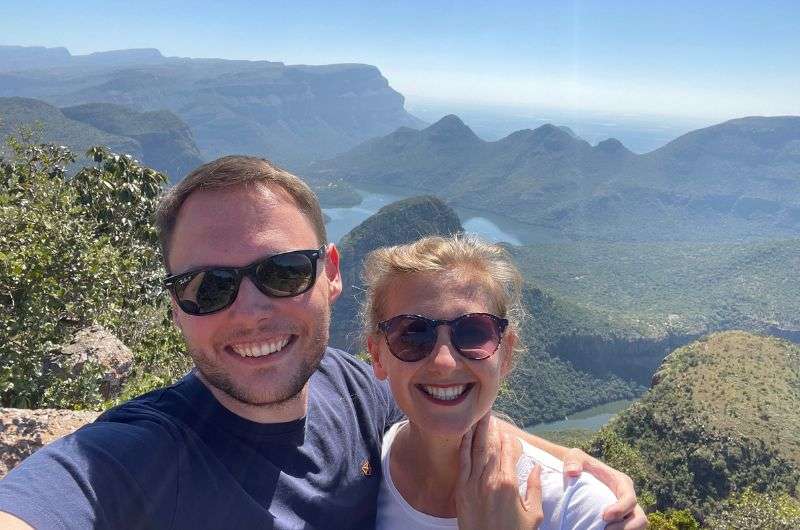
We are happy together on the road @ Blyde River Canyon, South Africa
Lastly, this is something you’ll need to start doing only a few days before you leave for your vacation. (Or make it a week if you’re the forgetful, scatterbrained type.) People either love packing or hate it, but either way, if you start properly organizing your stuff in advance, the process will be much easier.
Pro tip: Make lists—as many as possible. A list for clothes, a list for accessories, a list for toiletries, a list for medication, a list for all the necessary documents; you get the idea. Going through all these lists on your day of departure day will best ensure that you don’t forget anything. But what exactly should you put on all your lists...?
Some things to consider when making packing lists
For clothes
- What the weather will be like at your destination (it helps to check the forecast regularly in the week leading up to your trip)
- Whether there’s any dress code at any sites you want to go to (think temples and sacred sites, fancy restaurants or events you plan on going to, etc.), or any cultural dress code in your destination country in general
- How much walking you’ll be doing (don’t attempt to hike a mountain in platform heels)
For accessories
- Which plug outlets are used in your destination country
- What kind of travel bag(s) might be appropriate to use during each day (I recommend a fanny pack for keeping valuables safe)
- How much jewelry you’ll want to wear (don’t go full bling in poorer countries—it’ll just make you stand out as a rich tourist)
- Whether you’re likely to need help getting comfortable enough to sleep (by using a neck pillow, earplugs, and/or an eye mask)
- Which chargeable electronic devices you’ll be bringing with you
For toiletries
- Which products do you use on a daily basis
- How much of each product you’ll need for the duration of your trip (pro tip: use smaller, reusable travel containers to avoid overpacking)
- Whether you’ll need any additional products specific to your destination (such as insect repellent or high-factor sunscreen)
- Whether you can fit all your liquids into a 20 x 20-centimeter (7.8 x 7.8-inch) resealable plastic bag if you’re traveling without hold luggage
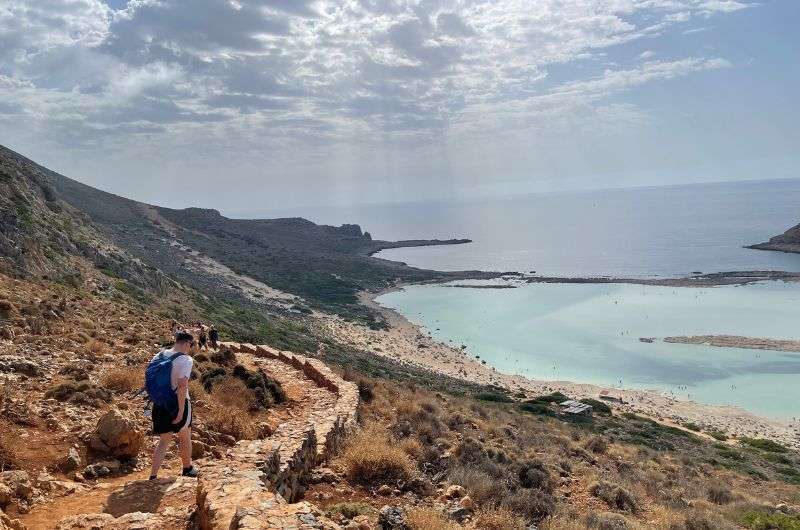
Packing smart for Crete—sun protection, comfortable shoes, and just enough to enjoy Balos Lagoon without overloading the bag
Check out my longer article on packing tips for international travel for more hacks, examples, and things to consider.
But having said all this, it's also important not to overpack! There’s nothing worse than dragging half of your possessions across the world, straining your back in the process, only not even to use half of them. (I’ve, ahem, come to learn over time that it’s women who are particularly bad with this. Sorry, not sorry.)
If you’re away for a longer time (say, a month), don’t try to bring absolutely everything you’d need for that length of time. Instead, for example, buy more toiletries when you need them, and there’ll always be a way to wash some of your clothes.
Conclusion: Now go plan that trip!
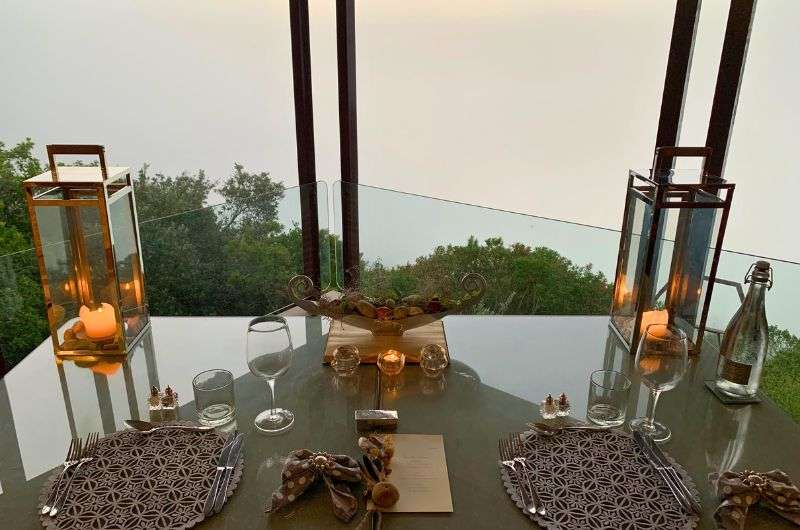
Ending the day with dinner and a view—sometimes, the best part of travel is just slowing down (Kambaku @ Sea Hotel, South Africa)
And that’s it! If you made it this far, congrats—you now know how to plan a trip like a seasoned traveler. No more relying on overpriced travel agencies, no more blindly booking things without a clue. You’ve got all the tools to plan your international adventure, whether it’s a European getaway, a tropical escape, or a full-blown backpacking expedition.
Now, stop procrastinating, start planning, and most importantly—book the damn tickets! Sometimes, browsing cool hotels can help get you started, or, if you really need help, see all the destinations on my travel blog to get inspired.
Because let’s be honest, the hardest part of traveling isn’t figuring out the logistics—it’s getting over the mental hurdle of actually committing to the trip. And once you do? You’re in for one hell of an experience.
FAQ 1: What’s the biggest mistake first-time travelers make?
The biggest travel mistake is trying to see and do everything. Overloading your itinerary will leave you exhausted and unable to enjoy the experience. And Americans, I’m looking at you—stop trying to see all of Europe in a week. You can’t even properly see one country in that time. If you spend more time hopping between cities than actually exploring them, you’re doing it wrong. Pick a country, stick to it, and actually experience it. Prioritize the things you actually care about, leave room for spontaneity, and don’t feel obligated to visit “must-see” places if they don’t interest you.
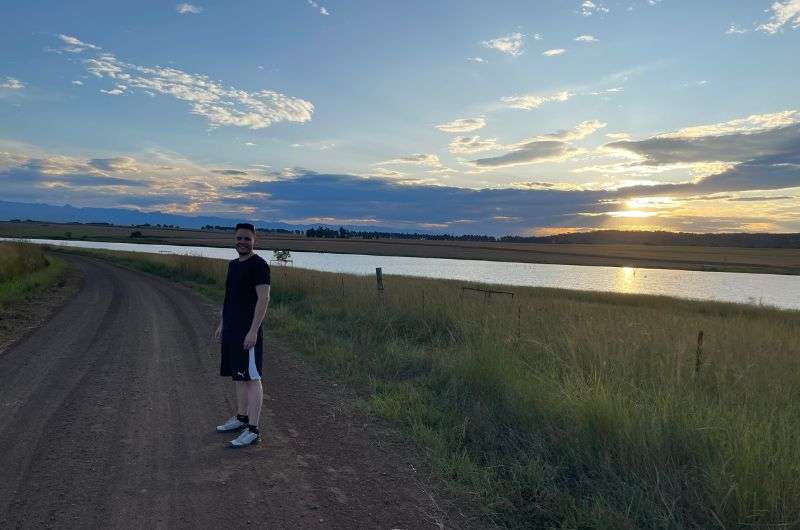
Planning your next great adventure? Make it simple and stress-free @ Dalmore Guest Farm, South Africa
FAQ 2: What’s the best travel tip you can give?
My travel tip is to be flexible and relax. Things will go wrong—flights will get delayed, plans will change, and Google Maps will betray you. Instead of stressing, adapt and roll with it. Sometimes, the best experiences come from unexpected situations. And remember, unless you leave your passport at home, everything will work out just fine. Anything you forget, you can buy once you arrive (unless your first trip is to the middle of the jungle, which I highly doubt). Also, rent a car. It gives you so much more freedom and makes travel life infinitely easier.
Now, go book that trip before you come up with another excuse!
This post contains affiliate links. I earn a small commission if you make bookings through my links at no additional cost to you. Thank you for your support!










Comments | Thoughts? Give us a shout!